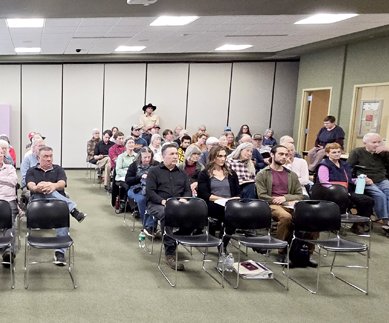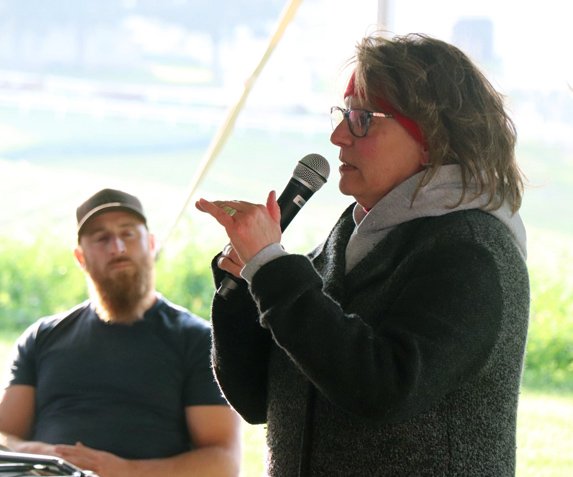About 30 members of the Hill Country Watershed Alliance (HCWA) gathered on February 18 at the Viroqua Eagles Club for a quarterly meeting. The Alliance is made up of members of four local watershed councils – Tainter Creek, Bad Axe Stewards, Coon Creek Community and Rush Creek.
After enjoying a hot pulled pork sandwich meal on a cold night, Alliance members shared updates from their groups, and took in several educational presentations. Presentations included an update from the Bad Axe Watershed Stewards (BAWS) soil probe, soil health monitoring project, a presentation about the Fields of Sinsinawa ‘Soil Carbon Benchmarking’ project, and an update about watershed council capacity building.
Council updates
BAWS’ Travis Klinkner explained that the highlight of the season for their group was an event on the McClurg farm near Bud with USDA-NRCS soil scientist Jamie Patton.
“At that event, we reached both current and future farmers, and had good participation from area youth,” Klinkner reported. “We plan to repeat that event in April this year, and since the McClurgs now have an excavator, we believe we’ll be able to have our soil pit too.”
Klinkner said that another big initiative of BAWS in 2024 was a field soil probe project, paid for with Vernon County Ho-Chunk funding. He said the group would hear from Vernon County Watershed Planner Samer Kharbush about that later in the agenda.
“We are investigating the possibility of holding a HCWA meeting at the Genoa Fish Hatchery next year,” BAWS member Al Seelow told the group. “The Hatchery is located where the Bad Axe River meets the Mississippi River, so it would be interesting to learn more about what they do there.”
Sydney Widell reported that the Coon Creek Community Watershed Council (CCCWC) funded lots of tree planting in 2024. She said the group is now organizing their ‘Coon Creek Confluence’ event, with a performance by Mollie B, scheduled for May 3 at the Snowflake Ski Club facility in Timber Coulee.
Brad Robson reported that the Tainter Creek Watershed Council is planning for a ‘Meet-and-Greet’ event on March 18 in Readstown. He said the Council has decided to expand their geographic boundary to include the Reads Creek, Trout Creek and Caswell Hollow watersheds.
Soil health project
Vernon County Watershed Planner Samer Kharbush reported to the group about the BAWS soil probe/soil health project begun in 2024.
“We have deployed 20 soil probes on farms, mostly in the Bad Axe River Watershed, with one in the Coon Creek Watershed,” Kharbush explained. “Kharbush said the probes are currently set to record data every three hours, but can be set to record more frequently if the goal is to measure the rate of water infiltration into the soil from rainfall.”
Kharbush said the probes record soil water and temperature data, and are able to measure the true soil profile, not slurry. The units, he said, are cable-free, battery-powered, and due to their design, are easy to relocate. Data is available through any web browser on a phone or laptop.
“Moving the probes between different areas on the farm can help producers make comparisons between different land covers,” Kharbush explained. “For instance, on the Klinkner Farm, probes have been placed in pasture, a hayfield, and a five-year prairie planting.”
BAWS member Kent McClurg noted that his family had used the probe to compare fields on their farm with a field where crops had been planted into a roller crimped rye cover crop.
“We found that in the roller crimped rye, soil temperatures were much more consistent,” McClurg explained.
Travis Klinkner expanded on this insight.
“We know that water hemp thrives in warmer soil temperature environments,” Klinkner said. “So one insight is that making management changes can be a tool for the farmer in managing weeds.”
McClurg went on to discuss various soil tests, and their pros and cons. He said that BAWS uses the Haney Soil Test, and he said the group is working to better understand the insights to be gained from those test results.
“One thing we’ve learned is that having more organic versus inorganic nitrogen in your soils can enhance plant availability and uptake, and reduce the nutrients being lost to leaching through the soil profile,” McClurg said. “The Haney Test is a useful measurement of the bioavailability of nutrients in the soil.”
McClurg said the Haney Test will calculate soil respiration, organic carbon, microbially active carbon, and the carbon to nitrogen ratio. From these results, the test software can provide the producer with a soil health calculation.
Fields of Sinsinawa
Fields of Sinsinawa project manager Julie Gerlach, and soil advisor Rick Bieber, travelled to Viroqua to share information with watershed council members about the ‘Soil Carbon Benchmarking’ project they have launched.
The ‘Fields of Sinsinawa,’ a farmer-led learning center, was established on land owned by the Sinsinawa Dominican Sisters after meeting with the late no-till legend and “godfather of soil health” David Brandt.
Their website explains:
“David Brandt, a nationally known mentor among soil enthusiasts, has made a lasting impact on farmers around the world with his passion for sharing the good news of healthy soil for a healthy planet. In a 2023 visit to Sinsinawa Mound, where the Sinsinawa River begins its 21-mile journey to the Mighty Mississippi, he recognized the Mound as a place where his message of holistic land stewardship and soil care practices would flourish. He planted the seed. This vision has taken root at Sinsinawa Mound in Southwest Wisconsin. Fields of Sinsinawa… brings the message of healthy soil for a healthy planet to the Midwest and beyond.”
Bieber told the group that he had farmed in South Dakota his whole life, and passed the farm along to his son in 2017. He said that his family had seen miraculous results from managing soil health on their farm over the course of 30 years, and found ways to reduce use of synthetic chemicals on their acres.
Bieber told the group that the goal of the Fields of Sinsinawa Carbon Benchmarking project is to develop a baseline of soil carbon in soils across the Upper Midwest.
“Ultimately, the goal of our work here in the Midwest is to create a ripple effect that can transform agricultural production across the nation, and the world,” Bieber explained. “Most soils contain tens of thousands of pounds of carbon per acre, along with vital stores of nitrogen, phosphorous, potassium, and all 18 essential nutrients required for life.”
Bieber said that the challenge is that these nutrients are often locked within the soil, making them largely inaccessible to plants. He said this is the result of decades of use of synthetic fertilizers, which he says disrupts the natural biological processes in the soil, weakening the symbiotic relationship between plants and the soil microbiome. He said that, over time, this leads to a cycle of dependency on inputs rather than biologically-driven nutrient availability.
“Starting in 2025, we are partnering with farmers and producer-led groups across Wisconsin to collect soil samples and land management data,” Bieber said. “This will help establish a benchmark for soil carbon levels and biological activity, providing a clearer picture of the current state of our soils.”
“We have soil probes outside in the truck, and will offer one per watershed council free of charge to help in collecting soil samples,” Gerlach explained to the group. “We’re looking for 3-5 producers in each watershed to partner with us in collecting the samples, which would cost about $190 apiece for the lab work.”
Bieber explained that, working with ReGen Labs, the tests each sample would undergo would be expanded to include a ‘Total Nutrient Digestion’ analysis report, and a Phospholipid Fatty Acid (PLFA) analysis, a method used to measure microbial biomass and community structure in soil and water.
“If a producer decided to participate, what is the duration of the commitment?” Travis Klinkner asked.
“For now, we are asking a producer only to participate one time, in order to help us establish a benchmark,” Bieber responded. “But ultimately, we hope that the results and insights will get farmers excited, and they will want to continue with additional soil sampling. We anticipate that this initiative will evolve into a long-term project.”
Bieber said that in part, their goal is to convince agriculture departments at land grant universities to expand their research to include the kind of management practices being modeled at Fields of Sinsinawa.
“What we want is for the land grant agriculture departments to see the physics, biology and chemistry of the soils as equally important,” Bieber explained.
For more details, or to sign up, interested producers can contact Julia Gerlach at 414-394-9973, or via e-mail at: juliagerlach442@gmail.com.
Capacity building
CCCWC’s Sydney Widell provided an update about a Wisconsin Idea Collaboration Grant that had been received, and deployed to support watershed councils in building capacity.
“Lake conservation groups across Wisconsin have a wide range of resources to turn to as they navigate the challenges that come with establishing their organizations, thanks to tools developed by UW-Stevens Point Extension Lakes,” Widell explained. “But there are fewer resources available for communities organizing at a watershed scale.”
Widell said that in an effort to address that gap, UW-Extension partnered with CCCWC and faculty at UW-Madison to meet the emerging needs of the state’s swiftly growing watershed conservation movement.
Widell explained that these resources include templates for defining board member roles, drafting articles of incorporation, and establishing organizational bylaws. She said the guidance and more is available on the Extension Lakes website.





